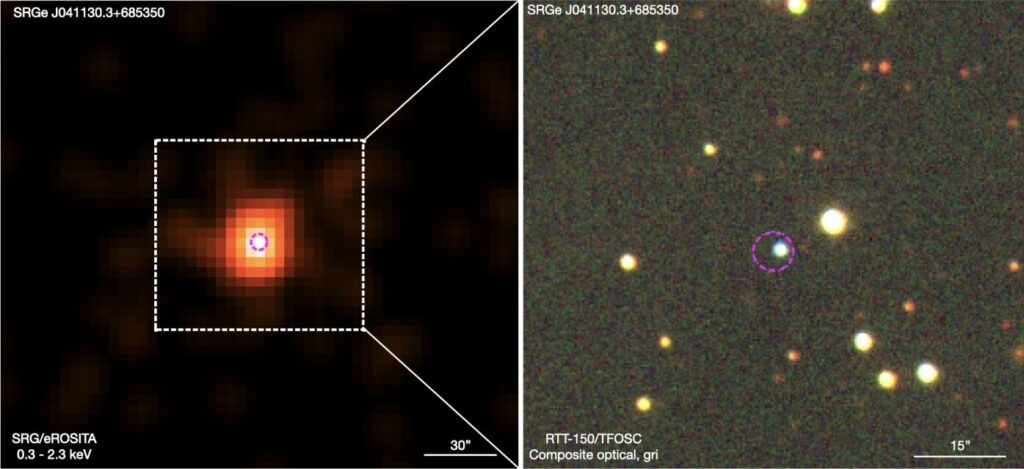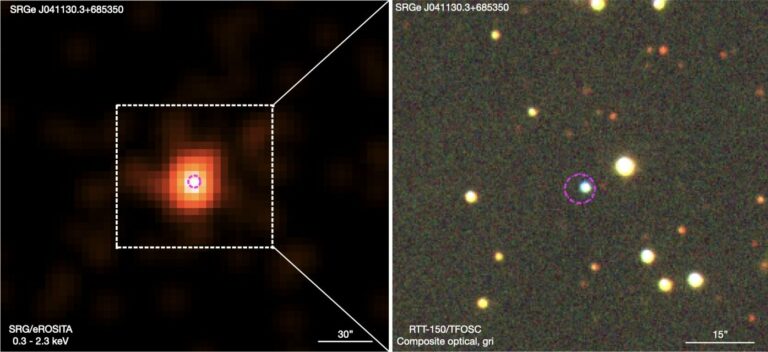Discovery of a Newly Found Cataclysmic Variable Potentially Housing a Brown Dwarf Companion
A new cataclysmic variable has been discovered by an international team of astronomers. This newfound system, known as SRGeJ041130.3+685350 or SRGeJ0411 for short, has an orbital period of around 100 minutes and may contain a brown dwarf. The team’s findings were published in a paper on January 4 in the Monthly Notices of the Royal Astronomical Society.

Cataclysmic variables are binary star systems in which a white dwarf primary star accretes matter from a companion star. These systems exhibit irregular increases in brightness followed by a return to a quiescent state. They have been observed in various environments, including the center of the Milky Way galaxy, the solar neighborhood, and open and globular clusters.
Led by Ilkham Galiullin from the Kazan Federal University in Russia, a group of astronomers discovered this new cataclysmic variable as part of a joint program involving SRG/eROSITA and the Zwicky Transient Facility (ZTF). By combining X-ray and optical data, this multi-wavelength campaign enables the search for and discovery of new systems of this kind.
The researchers described their study and characterization of the new eclipsing cataclysmic variable, SRGeJ0411, in their paper. SRGeJ0411 was identified as a CV candidate in the SRG/eROSITA all-sky survey due to its high X-ray to optical flux ratio of 0.6. Its optical spectrum exhibits prominent hydrogen and helium emission lines, which are typical for cataclysmic variables.
Observations revealed that SRGeJ0411 has an X-ray luminosity of approximately 2.4 nonillion erg/s in the 0.3–2.3 keV energy range, and its accretion rate is relatively low. The ZTF optical light curve shows significant eclipses of the system and no evidence of a major outburst.
Based on the study, SRGeJ0411 is situated approximately 1,056 light years away and possesses an orbital period of 97.53 minutes. The white dwarf within the system has a size equivalent to that of the sun, with an estimated mass of 0.84 solar masses. The temperature of the white dwarf has been determined to be 13,790 K.
Regarding the donor in SRGeJ0411, the authors of the research paper propose that it is a brown dwarf. This object has a radius smaller than 0.11 solar radii, a mass lower than 0.04 solar masses, and an estimated temperature below 1,800 K.
The researchers clarify that the characteristics of SRGeJ0411 indicate that it belongs to a new category known as “period bouncers.” These highly-evolved CVs have surpassed the minimum orbital period of 70 minutes and are now evolving towards longer orbital periods. Previous observations have shown that brown dwarfs are typically the donors in period bouncers.
Consequently, summarizing the findings, the astronomers have concluded that SRGeJ0411 is most likely an eclipsing period bouncer CV system. However, further investigations are necessary to confirm this hypothesis.
More information: Ilkham Galiullin et al., A Joint SRG/eROSITA + ZTF search: Discovery of a 97-min period eclipsing cataclysmic variable with evidence of a brown dwarf secondary, Monthly Notices of the Royal Astronomical Society (2024). DOI: 10.1093/mnras/stae012. On arXiv: DOI: 10.48550/arxiv.2401.04178
This article is republished from PhysORG under a Creative Commons license. Read the original article.
Do not forget to share your opinion with us to provide you with the best posts !




0 Comments